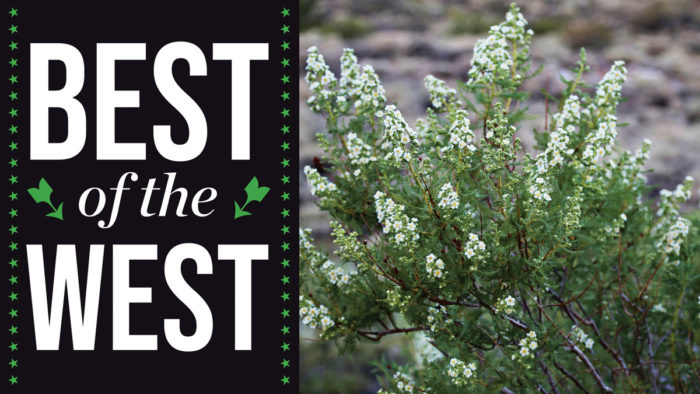
People on the coasts tend to think of much of the interior Western United States as all canyons and cowboys. The West has plenty of both, but so much more: the tallest and oldest trees on earth, glaciers, America’s highest rainfall regions, and not one but four desert regions. Drawing from the rich palette of plants native to this region, a gardener from almost anywhere could find the perfect plant for almost any garden conditions. I’ve selected 12 that I’ve seen thriving far beyond their often restricted native ranges. You can bring some of the magic of the Western vistas to your backyard with a few of these gems, all of which can often be found in better garden centers or through reputable mail-order nurseries.
Bright Blooms

A cheerful self-seeder
‘Denver Gold’ columbine • Aquilegia chrysantha ‘Denver Gold’
Zones: 3–8
Size: 24 to 30 inches tall and 18 inches wide
Conditions: Full sun to partial shade; thrives in fertile garden soil with moderate moisture; tolerates sun and heat; avoid planting in clay
Native range: Canyons of Colorado, Utah, Arizona, New Mexico, Texas, and northwestern Mexico
Most American columbines demand shade, bloom for just a few weeks, and are usually short-lived. If their seeds germinate, the progeny are often homely hybrids. ‘Denver Gold’ yellow columbine, a strain of our Colorado native species, evolved at Denver Botanic Gardens to break all the rules. It thrives in sun or shade, forms robust, long-lived clumps, and blooms for months on end, even without deadheading. Beware, though, because it can overwhelm delicate neighbors. ‘Denver Gold’ has proved itself in all parts of the United States to be a tough, reliable perennial for borders or woodland gardens.
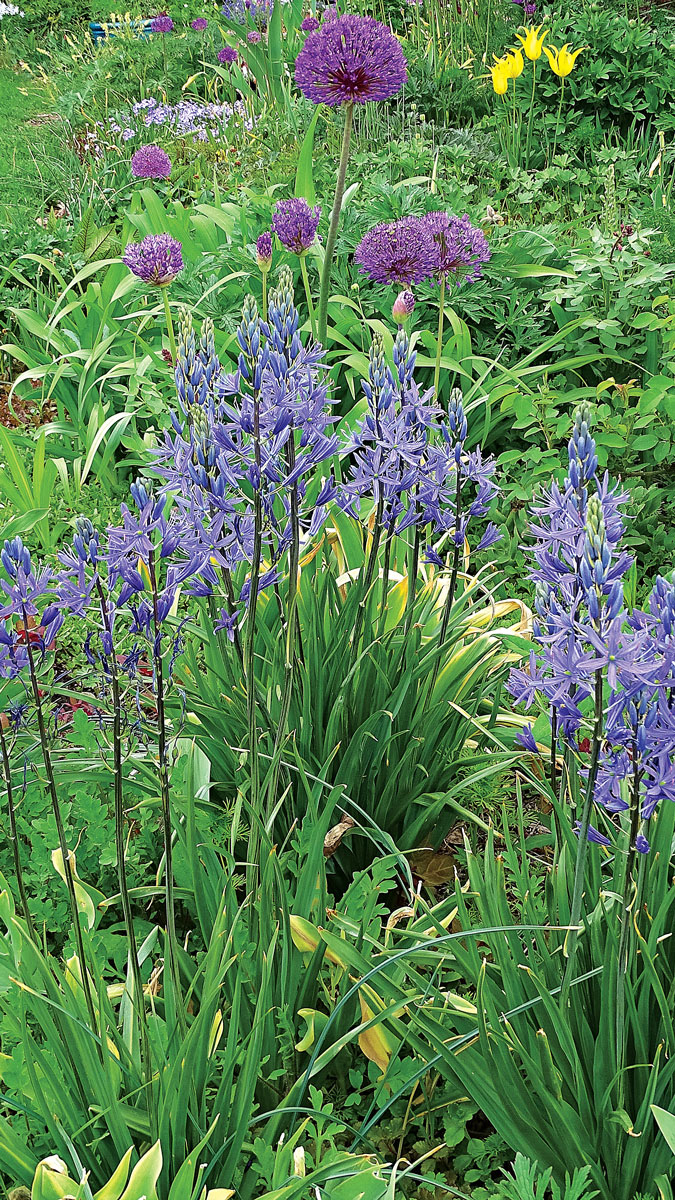
This native bulb sings the blues
Giant camas • Camassia leichtlinii and cvs.
Zones: 5–9
Size: 3 to 4 feet tall and 1 to 2 feet wide
Conditions: Full sun to partial shade; prefers fertile, acidic, humusy soil with good spring moisture but is OK with drier summer conditions
Native range: Mountain meadows west of the Cascades and Sierras from British Columbia to Southern California
We associate bulbs with Holland, but giant camas and the rest of its small genus are restricted entirely to North America. These tough natives tolerate an astonishing range of garden conditions, from soggy feet to summer dryness. The spires of brilliant purple-blue come after the big rush of daffodils and tulips and are an inspiring picture massed in a border or a meadow garden. Camas need moisture in spring and do best in sunny exposures, but they have proved to be extremely adaptable in gardens across much of our continent. You can find them sold at very reasonable prices in any bulb catalog, or even the bins of garden centers in fall.
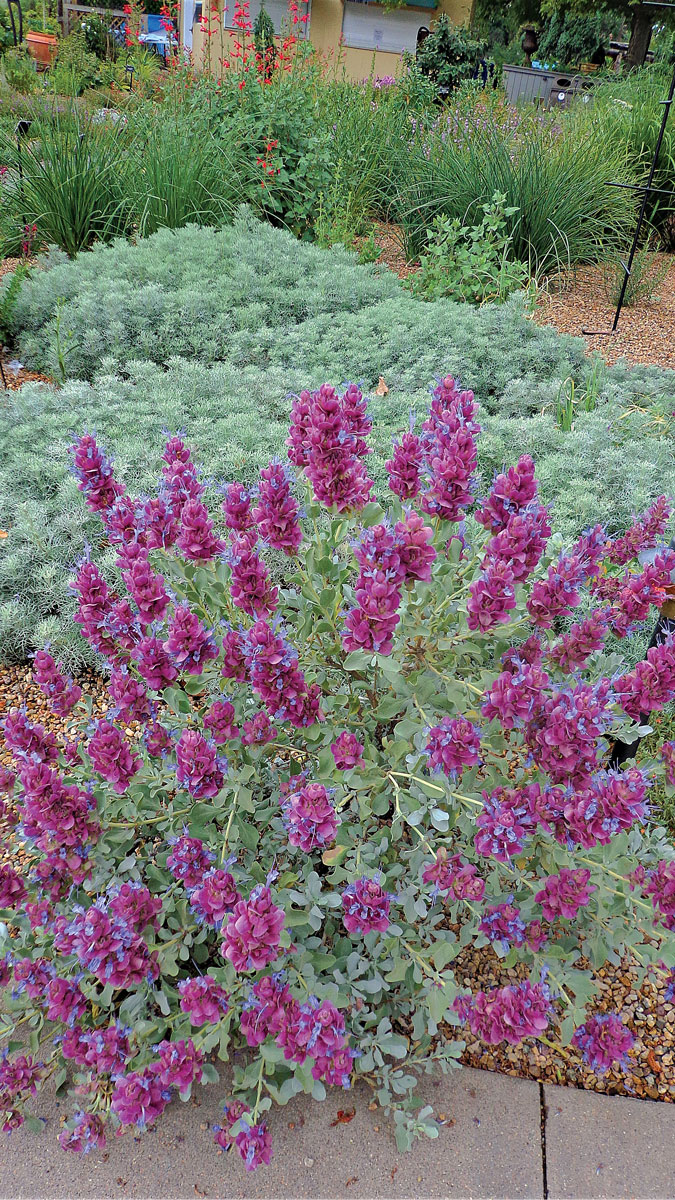
Plenty of cool color for a hot, dry spot
Mojave sage • Salvia pachyphylla and cvs.
Zones: 5–9
Size: 2 feet tall and 24 to 30 inches wide
Conditions: Full sun; average to dry, very well-drained soil
Native range: Higher-altitude California hills
Mohave sage has a name that implies it is a desert plant, but in fact it grows at rather high elevations in the Southern California mountains. It forms a silvery dome of whitish leaves topped with spectacular flowers throughout the summer months. The floral show is largely due to the brightly colored bracts subtending the flowers, which persist even when the less conspicuous flowers fade. This requires an “Arizona” microclimate in wet climates, but it is worth the extra effort. Few native wildflowers produce such a long show of colorful beauty.
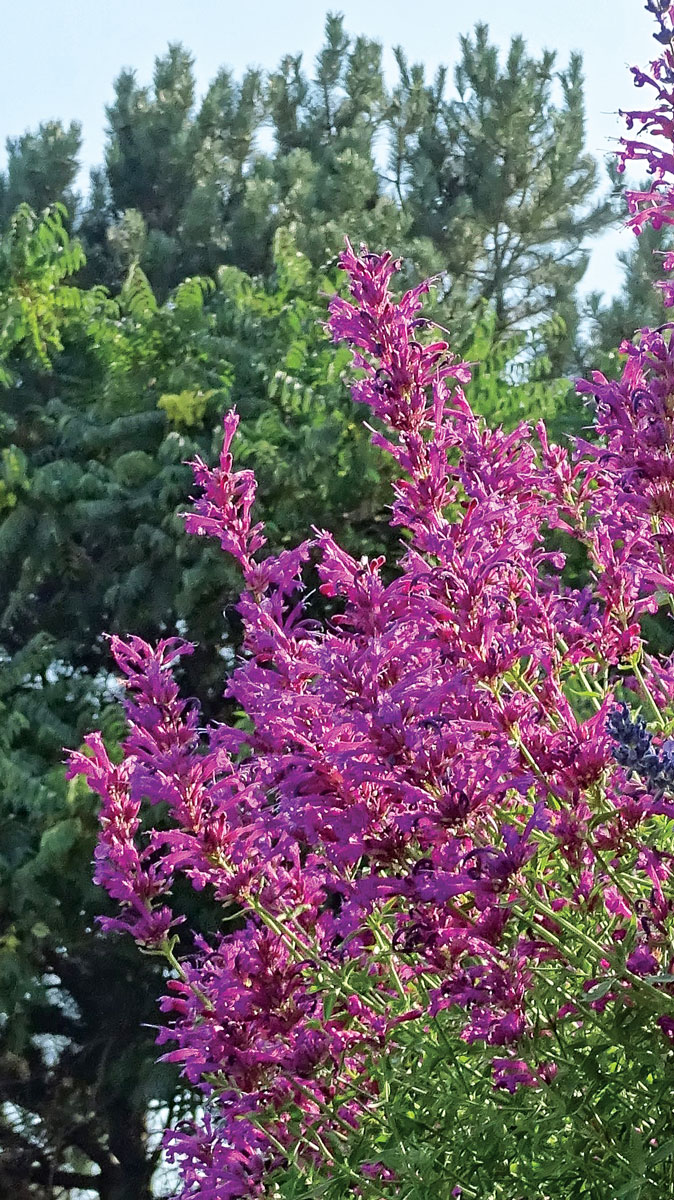
Pollinators find it intoxicating
Pink butterfly mint • Agastache cana
Zones: 5–9
Size: 18 to 36 inches tall and 1 to 2 feet wide
Conditions: Full sun; adaptable to average garden conditions but prefers naturally lean, very well-drained soil
Native range: Rare in the wild; found in the sky island mountains of New Mexico and western Texas
It is hard to believe that showy pink butterfly mint has only been in cultivation for a few decades. Its gorgeous magenta flowers last much of the summer, with a sweet scent that earned this plant the nickname “Double Bubble mint.” Within a decade of introduction, every seed company produced lines crossing this and its fellow Southwestern butterfly mints. But in my opinion, none of the hybrids and selections are as beautiful as the wild type. It is accommodating in the garden and does not need the hottest “Arizona” microclimate to persist, even in wet climates. It thrives in any sunny exposure on well-drained loam.
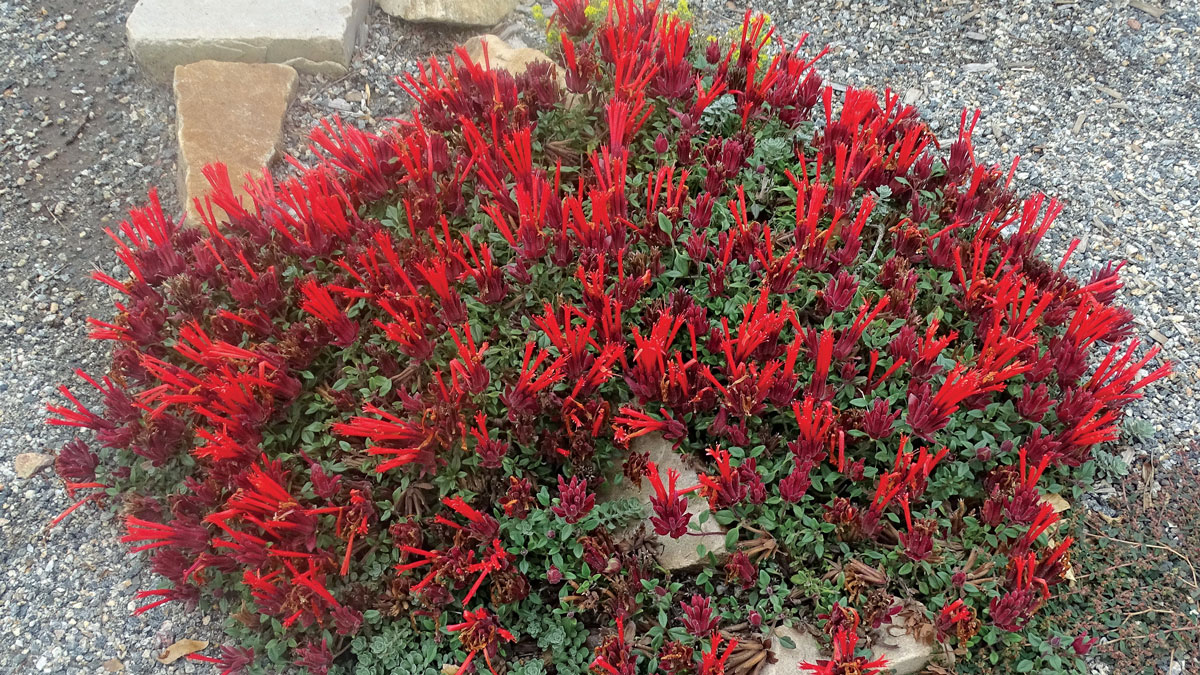
Expect a dazzling late-spring show
‘Marian Sampson’ scarlet horsemint • Monardella macrantha ‘Marian Sampson’
Zones: 5–9
Size: 4 inches tall and 4 to 8 inches wide
Conditions: Full sun; lean to average, sharply drained soil; good in containers, rock gardens, and along pathways
Native range: Coastal mountain ranges of Southern California and Baja California
I never dreamed that one of our showiest ground covers would come from the coastal Southern California mountains, but few plants I have grown have produced a longer, more spectacular season of bloom than ‘Marian Sampson’ scarlet horsemint. The flat mats of rounded, intensely aromatic foliage are practically obscured with ping-pong-size balls of brilliant scarlet from late spring to early winter. This plant can be grown in containers in mild climates, where it can trail at the edge of the pot. It has also proved hardy in Zone 4 when planted in the ground, and at Denver Botanic Gardens’ Chatfield Farms, it has formed a major ground cover in the children’s labyrinth.
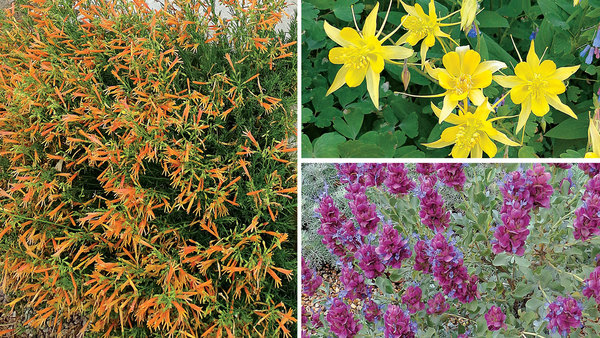 |
More info: Native Alternative to Common Garden Plants “The relatively adaptable and easygoing North American native plants in this article are excellent alternatives to commonly grown nonnative plants. These picks are as good—or even better—than the old standbys. Here’s how they compare.” |
First-Rate Foliage
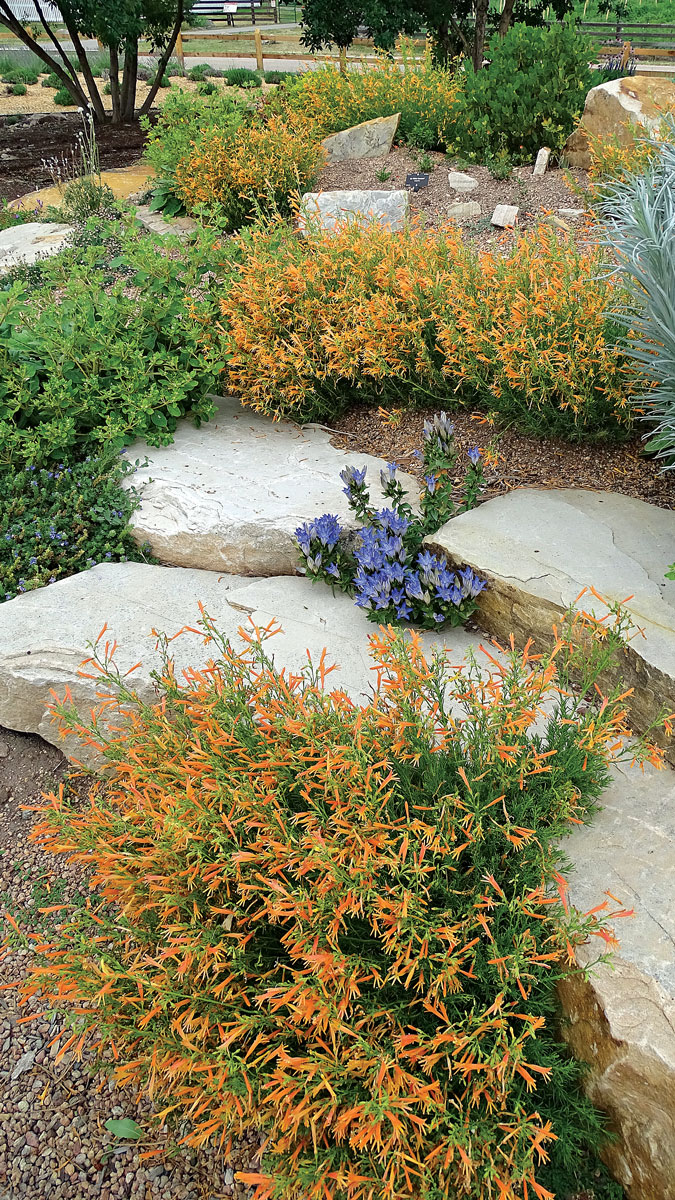
It’s evergreen and blooms for weeks
Pineleaf penstemon • Penstemon pinifolius and cvs.
Zones: 4–9
Size: 10 to 12 inches tall and 12 to 18 inches wide
Conditions: Full sun; average to dry, well-drained soil
Native range: Elevated rocky outcrops in the forested mountains of southeastern Arizona into western New Mexico
Pineleaf penstemon has foliage like a compact dwarf conifer. The typical brick red–flowered form of this species is popular in Europe and throughout much of the United States. Some know the yellow sport (‘Mersea Yellow’) that appeared mysteriously in England not long after the Chernobyl disaster. A bright orange sport appeared at Denver Botanic Gardens promoted by Plant Select as SteppeSuns™ Sunset Glow penstemon (Penstemon pinifolius ‘P019S’, pictured). It is as vigorous and long blooming as the typical form, although I find the burnt orange flowers much more attractive. I am sure this will also become a garden staple in coming years.
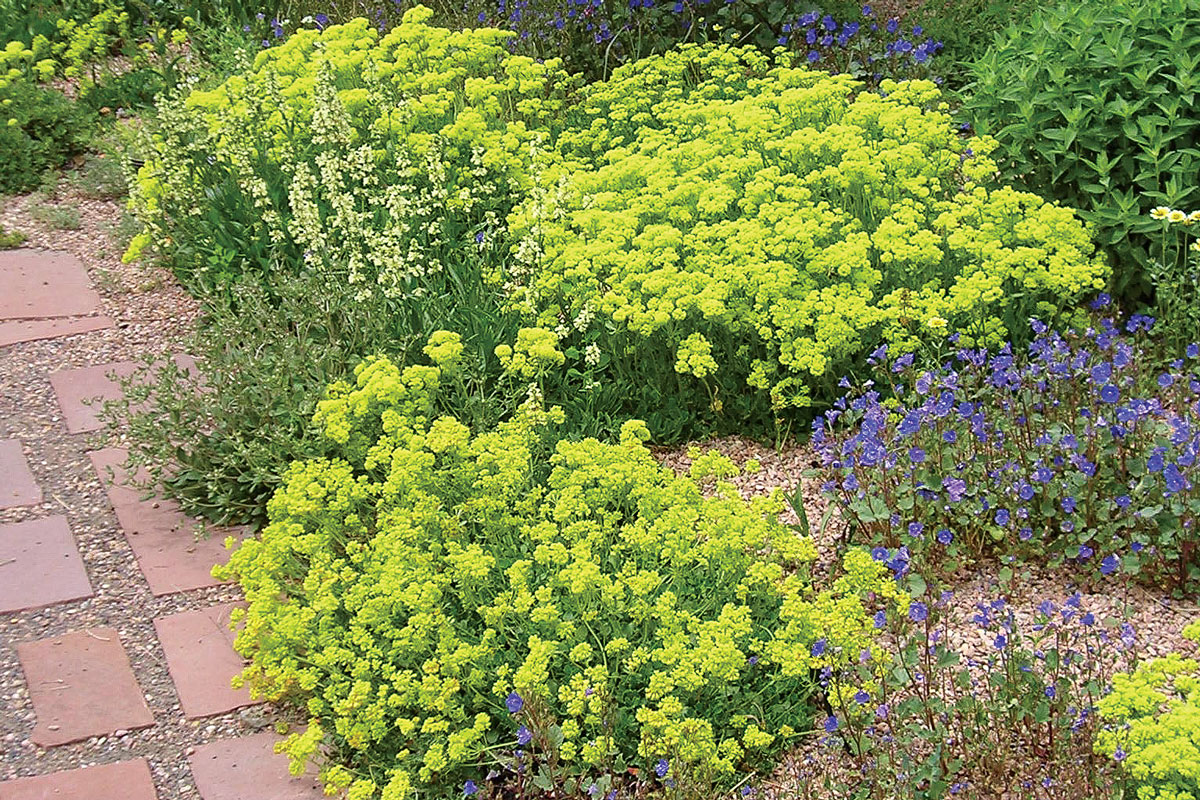
There’s nothing better than four seasons of interest
Kannah Creek® buckwheat • Eriogonum umbellatum var. aureum ‘Psdowns’
Zones: 3–8
Size: 12 to 15 inches tall and 1 to 2 feet wide
Conditions: Full sun to partial shade; lean to average, well-drained soil (mulch with nonabsorbent material such as gravel)
Native range: Straight species grows throughout the Western United States in dry steppes, desert, and sunny exposures in the mountains; this selection is from the Kannah Creek region of western Colorado
Sulphur flowers, or buckwheats, are a conspicuous and showy element in Western landscapes. Eriogonum umbellatum is perhaps the most abundant and universal, with dozens of subspecies growing in all manner of habitats. The Plant Select program of Denver Botanic Gardens and Colorado State University selected Kannah Creek® buckwheat, a form from western Colorado. It makes wide mats of deep green rounded leaves that turn a brilliant wine red in winter. In early summer the mats are obscured with masses of yellow umbels, which turn orange and red as they age. In wet climates this plant may require a bit of the Arizona treatment—lots of sun and good drainage.
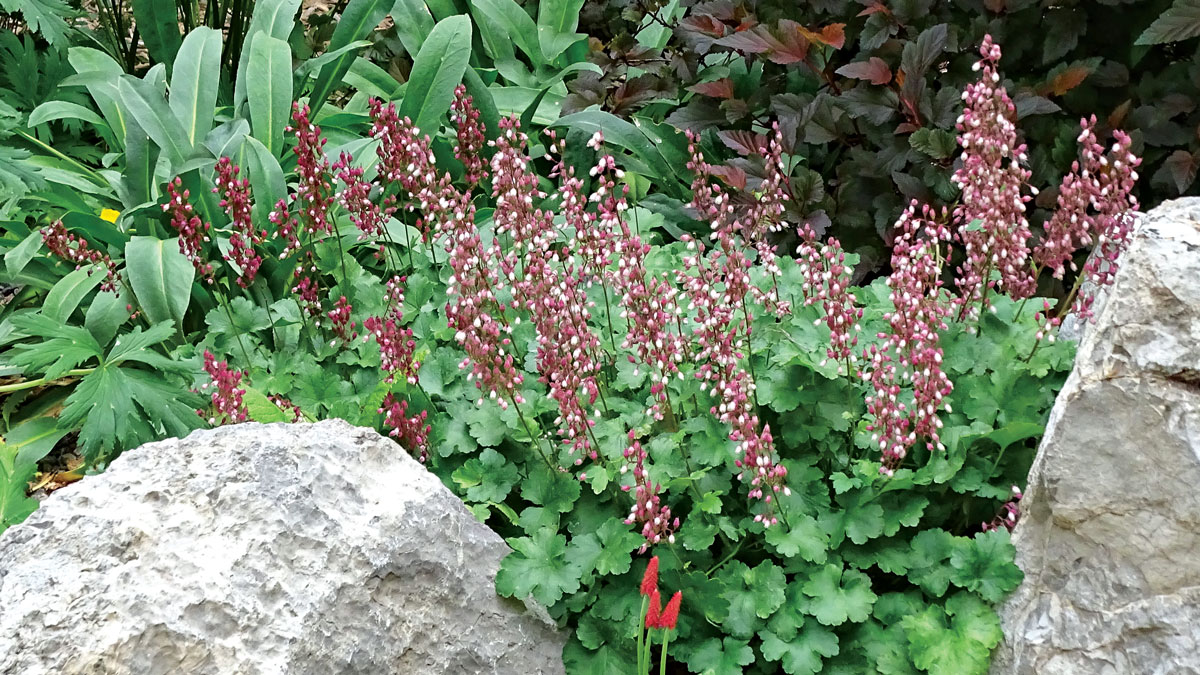
An adorable hummingbird magnet
Sandia alumroot • Heuchera pulchella
Zones: 4–7
Size: 10 to 12 inches tall and 4 to 8 inches wide
Conditions: Full sun to partial shade; moderately moist, well-drained soil, although partial shade will help it tolerate drier soil
Native range: Sandia Mountains region of New Mexico
Thanks to the extraordinary wizards at Terra Nova nursery, most garden centers in North America have benches of Heuchera cultivars with almost gaudy foliage colors. However, few hybrid heucheras can rival the species for beautiful flowers. In the wild, Sandia alumroot is largely restricted to central New Mexico, but it has proven itself from coast to coast as a perfect miniature. Its attractive scalloped foliage is topped in early summer with bright spires of pink-tinged flowers. It is great for a rock garden or for edging a woodland path.
Excellent Texture

Misty clouds of color transform a sunny bed
Undaunted® ruby muhly grass • Muhlenbergia reverchonii ‘PUND01S’
Zones: 5–9
Size: 2 to 3 feet tall; 18 to 24 inches wide
Conditions: Full sun; adaptable to many soil types, including heavy clay; tolerates heat, humidity, and cold
Native range: Northern Texas and southwestern Oklahoma
More and more gardeners are learning the power of grasses as a foil for showier perennials. And some grasses, like Undaunted® ruby muhly grass, produce a floral display that rivals that of the forbs. This tough selection of a native Texas grass blooms almost two months before the more tender muhlies, and its spectacular halo of purple flower heads glows with unearthly beauty for months. It has proved a reliable garden plant in California and in well-drained situations on the Eastern seaboard. I expect it will become a landscape classic like its cousin ‘Blonde Ambition’ blue grama grass (Bouteloua gracilis ‘Blonde Ambition’, Zones 4–9), another stellar Western grass.
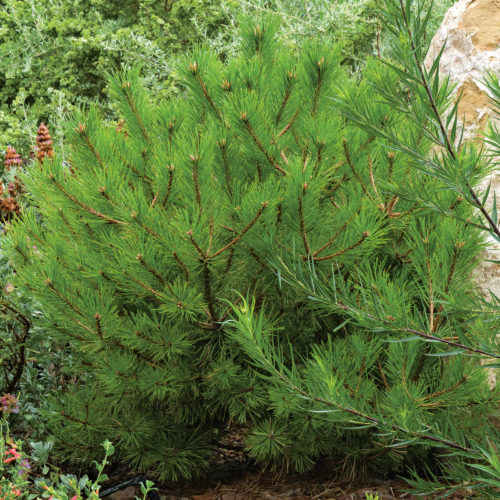
Compact perfection for a hot, dry spot
Dwarf pinyon pine • Pinus edulis (dwarf cvs.)
Zones: 5–8
Size: 24 to 30 inches tall and wide
Conditions: Full sun; average to dry, very well-drained soil
Native range: Southwestern United States
Mugo pines (Pinus mugo, Zones 2–7) have been a staple of foundation plantings forever, but in especially hot exposures and mineral soils, dwarf pinyon pines now offer a more compact alternative. The main component of Western “pygmy” forests, pinyon pine covers millions of acres of the Colorado plateau and the Southwest. The typical form of the species can grow to 20 feet or more, but a number of witch’s broom–sourced cultivars are being grafted and distributed through wholesale nurseries. A dwarf pinyon pine could be an elegant, long-lived anchor for a sunny slope almost anywhere in North America.

A silvery-leaved statement plant
Fernbush • Chamaebatiaria millefolium
Zones: 4–9
Size: 6 to 8 feet tall and wide
Conditions: Full sun; average to dry soil; tolerates sand and clay
Native range: Most of the Western United States
Shrubs are everywhere in the West, but not many can rival the showy bounty of Eastern native shrubs. Western shrubs often have gray foliage and can grow rangy with too much water, but fernbush is an exception. As tough as any Westerner, it can behave more seemly in a garden setting. It does best in the hottest exposures, and drainage is a must, yet it will adapt to a wide variety of sites and soil types. The ferny, silvery foliage boasts a rich, balsam-like aroma when brushed against; its midsummer flowers resemble a glorified white yarrow. It responds to tip pruning and shaping, so you can maintain its compact Western look in wet climates.
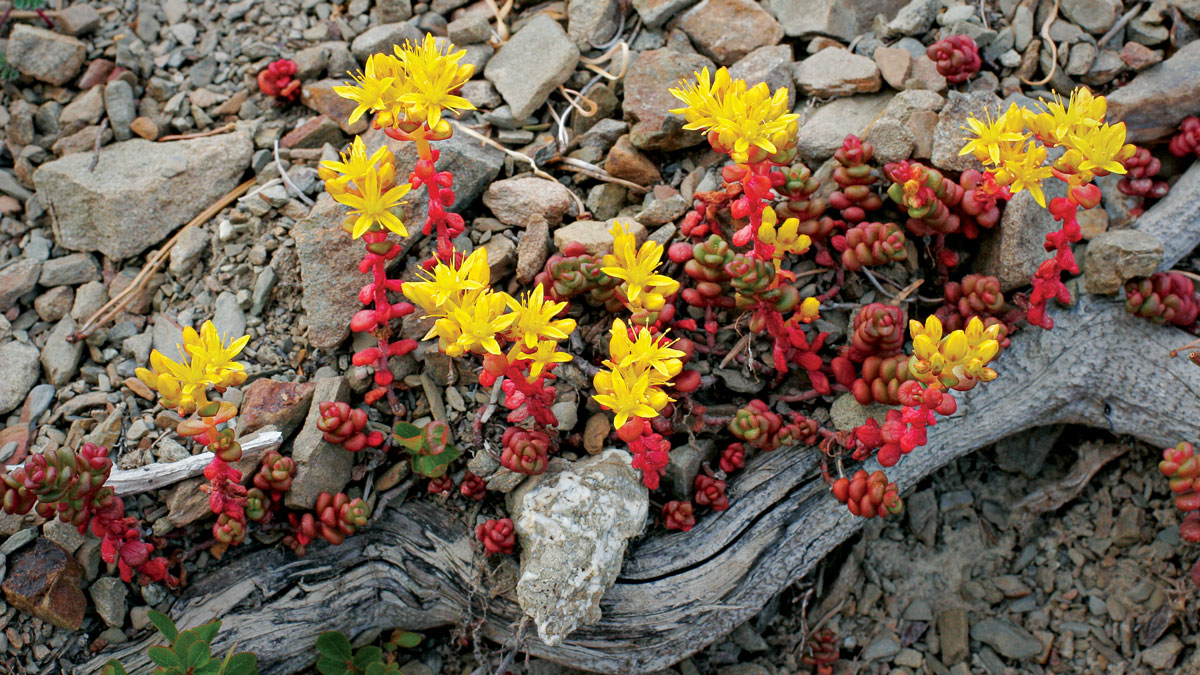
Adds fine texture to the rock garden
Old man’s bones • Sedum divergens
Zones: 4–9
Size: 2 to 4 inches tall and up to 18 inches wide
Conditions: Full sun to partial shade; average to dry, well-drained soil; great for rock walls, containers, raised beds, and rock gardens
Native range: Middle and high elevations of the Cascade Mountains of Oregon; often found on recent road cuts and rocky, gravelly cliffs
Old man’s bones is widely sold by garden centers, perhaps due to its delightful common name, but also for its knobby, bubble-like clusters of foliage. This far-western sedum species is less indestructible than others in its genus; it is used to a gentler, more maritime climate.
I have found that it is a reliable perennial in Colorado if planted with some shade on a well-drained corner of the rock garden. Happily situated, it produces handsome clusters of showy yellow flowers. Unlike so many Eurasian sedums, this will never become a pest, breaking off and rooting from the smallest leaf fragment. It’s worth a bit of effort, if only for its perfect common name.
Panayoti Kelaidis is senior curator and director of outreach at Denver Botanic Gardens.
Sources
- Far Reaches Farm Port Townsend, WA; 360-385-5114 farreachesfarm.com
- Fossil Creek Nursery Fort Collins, CO; 970-226-4924 fossilcreeknursery.com
- High Country Gardens Shelburne, VT; 800-925-9387 highcountrygardens.com
- John Scheepers Bantam, CT; 860-567-0838 johnscheepers.com
- Perennial Farm Marketplace Glen Arm, MD; 410-592-6106 perennialfarmmarketplace.com

















Comments
Log in or create an account to post a comment.
Sign up Log in